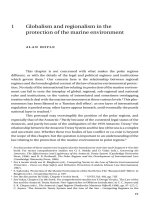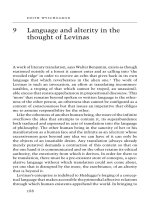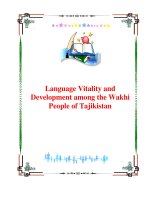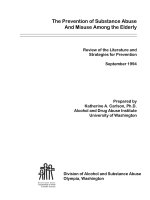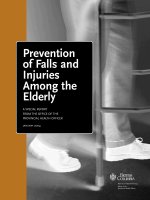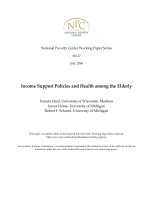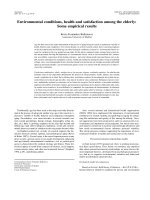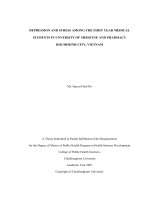Memories of martyrdom and landscapes of terror fear and resistance among the malays of southern thailand
Bạn đang xem bản rút gọn của tài liệu. Xem và tải ngay bản đầy đủ của tài liệu tại đây (2.06 MB, 140 trang )
MEMORIES OF MARTYRDOM AND LANDSCAPES OF TERROR:
FEAR AND RESISTANCE AMONG THE MALAYS OF SOUTHERN
THAILAND
MUHAMMAD ARAFAT BIN MOHAMAD
NATIONAL UNIVERSITY OF SINGAPORE
2007
MEMORIES OF MARTYRDOM AND LANDSCAPES OF TERROR:
FEAR AND RESISTANCE AMONG THE MALAYS OF SOUTHERN
THAILAND
MUHAMMAD ARAFAT BIN MOHAMAD
(B.A. (Hons.), NUS)
A THESIS SUBMITTED
FOR THE DEGREE OF MASTER OF ARTS
SOUTHEAST ASIAN STUDIES PROGRAMME
NATIONAL UNIVERSITY OF SINGAPORE
2007
i
STATEMENT OF ORIGINAL AUTHORSHIP
This thesis represents my own work and research and I have duly acknowledged
the sources and information which I have consulted for this project. The total
word count for this thesis is 30,645.
Muhammad Arafat Bin Mohamad
ii
ACKNOWLEDGMENTS
“My friends are my estate.” – Emily Dickinson
“No duty is more urgent than that of returning thanks.” – Anonymous
A thesis is never complete without acknowledging those who made it possible. I
am grateful to have been blessed with the friendship of many wonderful people;
it is, thus, a privilege of mine to be able to mention them here.
In Thailand,
I would like to express my appreciation to all individuals in Pattani, Yala, and
Narathiwat whom I have met since 2002. Their warmth and readiness in granting
me space their lives is truly cherished. Amongst them, Ayah Leh, Bang Ae, Bang
Mat, and Bang Tah require special mention. Over the past 5 years, they have
been such magnificent friends, family, teachers, and compadres; may peace
come to southern Thailand soon!
In Singapore,
My sincerest gratitude and love go out to my family. To my wife, Firhana, your
unflagging belief in me, and my goals in life, is treasured. Your company in trying
times never fails to lift my spirits up. To my one‐month old son, Ilhan Mikhail,
may the way you live your life in future bring goodness to others.
Teachers are truly a precious breed of humans. My greatest heartfelt
appreciation is reserved for them; especially for Dr Irving Chan Johnson, to
whom I am greatly indebted for his academic guidance as well as for the great
opportunities that have been laid before me.
Recognition also goes to Associate Professor Goh Beng Lan, from whom I draw
inspiration and could always solicit advice with ease. Much knowledge has also
been inherited from her since our first meeting during my first week as an
undergraduate in NUS.
It is almost obligatory for me to mention Professor Reynaldo Ileto. His life and
attitudes as a scholar has been a beacon in my fledgling one.
iii
Some of the best times of my life have been spent with the ‘inhabitants’ of the
“Grad Room”; especially with Arthur, Danny, Idham, James, Jun, Kar Yen, Shakti, Shao
Han, Surya, Thiru, and Tiffany. I will truly miss the collegiality amongst them.
To Miss Lucy Tan, thanks for tolerating all the trouble given in administrative
matters.
Finally, I would like to give thanks to the Faculty of Arts and Social Science, NUS,
for making funds that made this research enterprise possible through the
Graduate Research Scholarship as well as the Graduate Research Support
Scheme.
iv
TABLE OF CONTENTS
STATEMENT OF ORIGINAL AUTHORSHIP ............................................................................. i
ACKNOWLEDGMENTS ......................................................................................................... ii
TABLE OF CONTENTS.......................................................................................................... iv
SUMMARY .......................................................................................................................... vi
INTRODUCTION: ESSENTIALISM AND THE MALAYS OF SOUTHERN THAILAND .................. 1
CHAPTER ONE: VIOLENCE, FEAR, UNCERTAINTIES, AND POLITICS: SOUTHERN THAILAND
IN A CLIMATE OF FEAR ..................................................................................................... 12
Change in Atmosphere for Research in southern Thailand .............................................. 16
Climate of Fear: Life in southern Thailand’s Violence‐Wrecked Landscape ..................... 18
Sources of Fear .............................................................................................................. 20
Rumors ...................................................................................................................... 22
The Puzzle over the Identities of Perpetrators of Violence ...................................... 25
Everyone is at Risk: the Need to Exercise Extra Caution .......................................... 28
The Distressing Policies of the Thai‐state ................................................................. 29
Political Fear and Discipline: Using Fear as a Vehicle of Power .................................... 31
“Panopticism” of the Thai‐State and the Insurgents .................................................... 34
The Non‐Passivity of the Non‐Partisans ........................................................................... 36
Conclusion: The Incessant Resistance of the Malays .................................................... 40
CHAPTER TWO: HEROES, REBELS, OR VICTIMS: “TOMBS OF MARTYRS” AND MALAY
MEMORIES OF VIOLENCE .................................................................................................. 42
Kubo Tok Ayah: A Platform for the Production of Malay Memories of Violence ............. 45
Makam Shuhada Trajedi Pada Hari 13 Tanwakhom 2518: Tombs of the Martyrs of the
Tragedy of 13 December 1975 ...................................................................................... 46
The Tragedy of December 1975 in Malay Writings .................................................. 50
Malay Memories of the “Tragedy of 13 December 1975” ....................................... 55
The Impersonality of Historical Writings .................................................................. 59
“Tombs of Martyrs” as Monuments of Injustice .............................................................. 61
Monumentalizing the Shuhada of 28 April 2004 at Jaha and Sebayo .......................... 65
Megalithic Statues: Monuments and Politics in Thailand ................................................ 76
The Obscurity of the “Tombs of Martyrs” ........................................................................ 79
v
Conclusion: Cemeteries as Windows to the Past ............................................................. 82
CHAPTER THREE: THE PAST IN THE PRESENT: THE IMPORTANCE OF HISTORY IN
PRESENT‐DAY RELATIONS BETWEEN THE THAI NATION‐STATE AND THE MALAYS OF
SOUTHERN THAILAND ....................................................................................................... 84
What was Patani? : Contested histories of the Malays of southern Thailand .................. 87
Malay Writings about “Patani” ..................................................................................... 87
“Patani” in Malay Memories ......................................................................................... 90
“Patani” as Siamese Territory: “Patani” in Thailand’s Nationalist History ................... 99
A History of Thailand’s history ................................................................................ 100
History or Myth? ..................................................................................................... 103
After The Defeat: Malay Memories of Collective Suffering after Siam’s Invasion of Patani
in 1786 ............................................................................................................................ 105
Fear, Memory, Identity, and Resistance ......................................................................... 109
Conclusion: Anti‐State, but not Separatists .................................................................... 115
CONCLUSION: ON THE NEED TO COMBAT ESSENTIALISM ............................................ 118
BIBLIOGRAPHY ................................................................................................................ 126
vi
SUMMARY
The re‐emergence of an insurgency in January 2004 has generated much
attention to the largely Malay‐populated provinces of Southern Thailand. Since
then, there has been a proliferation of published written works on the issue in
the form of newspaper articles, reports, as well as scholarly writings. Yet, the
issue remains largely perplexing for observers of the political violence including
academic, public intellectuals, and the Thai‐government, amongst others.
This thesis attempts to shed some light on the political turmoil through
the author’s observation of the everyday lives of Malays living in the area. It
contends that Malay memories of violence between their community and the
Thai‐state are consequential in the formation of its contemporary members’
attitudes towards the Thai‐state and its agents such as the civil service and the
security forces.
The Malay community of southern Thailand, however, must not be
viewed as a monolithic group. While some amongst them take up arms and join
the insurgency, many other do not. They resist the Thai‐state is other ways.
Chapter one discusses the fear that grips the social atmosphere in
Thailand’s southernmost provinces of Pattani, Yala, and Narathiwat. It argues
that fear is used as an instrument of power for the Thai‐state as well as the
vii
insurgents; both of whom aims to govern the political actions of the Malay
residents of these three provinces. Yet, many Malays exercise agency by refusing
to take sides with neither the Thai‐state nor the insurgents. Instead, they adopt a
‘third position’ that commits to the use of peaceful means to resolve the conflict.
Chapter two is about Malay resistance to the Thai‐states authority in the
production of history of the Thai nation‐state as well as its Malay population in
southern Thailand. More specifically, this chapter discusses the creative agency
of some Malays who build graves in the form of monuments in order to
memorialize their interpretations of certain violent events in the history of their
community’s relations with the Thai‐state.
The varying conceptions of the histories of the Malays and their historical
relations with the Thai nation are discussed in chapter three. More specifically, it
will be shown that the conflicting traditional Malay and Thai nationalist
discourses impacts on the way that other members of the Thai society view the
Malays and vice‐versa.
1
INTRODUCTION:
ESSENTIALISM AND THE MALAYS OF SOUTHERN
THAILAND
“What do you think? Can they find the solutions to this
problem? I don’t think so. They can’t just come here for a few
days each time and expect to find solutions. You, on the other
hand, come here and stay in the village for months. You help
the villagers with their work at sea; you do construction work
with them; sit at the coffee-shop and talk to them. That’s the
way it should be. But can you find the solution?”
That was Khruu Jan’s1 response to me after I asked for his
opinion on the prospects for the National Reconciliation
Commission (NRC)2 finding solutions to the on-going violence
that has wrecked the socio-political landscape of Thailand’s
southern provinces of Pattani, Yala, and Narathiwat. I was
gratified by Khruu Jan’s appreciation for my approach to
research, but I responded to his final question with a “no”.
1
Khruu means “teacher” in Thai. Khruu Jan is a teacher in a primary school in Pattani.
Although he original hails from another province in southern Thailand, Trang, he now calls
Pattani his hometown; he has spent more than thirty years in Pattani as he was posted to the
school immediately upon completing his training as a teacher.
2
The National Reconciliation Commission (NRC) was set up in March 2005 under the
initiative of Thailand’s Premier Thaksin Shinawatra (2001-2006). The commission was tasked
with exploring possible solutions to southern Thailand’s social turmoil through consultation
with the Malay community of southern Thailand. The commission was disbanded after
submitting its report in June 2006.
2
Khruu Jan then added, “Many researchers come here and tell
us that they want to do research. But, they are all the same.
They stay for a week and then go back to Bangkok. Then, they
come back six months later and repeat this. After that, they
claim to have done research here for six months.” My foster
brother3, Bang Ae, who was listening to our conversation
nodded in agreement.
Khruu Jan’s statement about researchers is perhaps too sweeping.
Researchers are not a monolithic category of people. There are those who
continue to conduct residential field research in the midst of daily violence in
the provinces of Pattani, Yala, and Narathiwat, in southern Thailand. The
current wave of violence in the area began when an army camp in Narathiwat
was raided by a group of unknown assailants. The raiders killed four soldiers
before making off with more than one hundred assault rifles; meanwhile,
seventeen schools and three police posts were burnt down simultaneously.
(Bangkok Post 2004c) According to Bang Ae, in a telephone conversation the
next day on 5 January 2004, some people blamed the attacks on bandits,
while others predicted a return of armed separatist movements, which had
begun to dissipate following the government’s granting of amnesty to
3
Abang angkat in Malay. I found out that my maternal ancestor originate from southern
Thailand when I went through my late-grandfather’s journals in 2002; after visiting the area
several times. On a subsequent visit, I whispered to myself saying that it would be pleasant
to meet some of my own relatives in southern Thailand. Bang Ae and Bang Mat, another
Malay man in his early forties, who had overheard my comment then offered to adopt me as
a foster younger brother, adik angkat. The three of us have remained close since; they have
since attended important events of my life such as my undergraduate graduation as well as
my wedding ceremony.
3
insurgents in 1981. (McCargo 2007b) “Just when we thought that it (the
separatist movements) was over and we can finally move on”, said Bang Ae
who was anticipating the tough times that would follow the resumption of
the insurgency.
Pattani, Yala, and Narathiwat are the three southernmost provinces of
Thailand that border with Malaysia. The majority who live here are MalayMuslims, a large number of whom identify with the historical Malay kingdom
of Patani4 . The kingdom of Patani flourished in the area from early sixteenth
century until 1786 when it was finally invaded by Siam, then ruled by Rama I,
after several failed attempts by the latter. (Syukri 2005) Armed separatist
activities in the area intensified in the 1970s when earlier peaceful demands
for independence were not met. (A. Malek 1993) The authorities, however,
appeared to have successfully established peace with the Malay population
when there was a significant reduction in incidence of armed attacks on
public officers in the 1990s.
The then Defense Minister, General Thamarak Issarangura, sent the
nation into frenzy when he claimed during a cabinet meeting that the
insurgents aimed to take control of Narathiwat in 1000 days and would hoist
their flag at Thaksin Rajanivej Palace to mark their success. (The Nation 2004)
This did not happen, but the violent attacks such as drive-by shootings,
bombings, and arsons, escalated and would soon become a daily event.
4
In this thesis, Pattani (spelt with 2 ‘t’s) shall refer to the province in present-day Thailand;
Patani (spelt with a single ‘t’) shall then refer to the historical Malay kingdom.
4
Two violent clashes between Thailand’s security forces and members
of the Malay community have generated much interest in the on-going
political conflict in southern Thailand; the first incident took place on 28 April
2004 while the second one on 25 October 2004. On 28 April 2004, militants
attacked eleven security posts and checkpoints around provinces of Pattani,
Yala, and Songkhla simultaneously. (Satha-Anand 2007) By the end of that
day, more than one hundred of the militants, who were mostly armed with
machetes and a few rifles, were killed in clashes that ensued between them
and the Thai security forces at various locations. (Bangkok Post 2004b) This
event attracted much attention and the government was criticized for the
military’s extreme use of force; 32 militants who had taken refuge at the
Pattani’s Krisek Mosque were allegedly shot at point-blank. (Bangkok Post
2004a)
The second incident took place on 25 October 2004. It began with
more than one thousand Malay-Muslim protestors gathering outside a police
station in the district of Tak Bai, Narathiwat. The crowd demanded the
release of six village defense volunteers who were withheld on suspicion that
they gave their weapons, which were issued by the government, to separatist
militants. More than eighty of the demonstrators subsequently died as a
result of the security personnel’s violent handling of the crowd; rifles were
fired in the direction of the crowd, demonstrators who were caught by the
security officers were stamped upon, and then they were stacked into army
trucks and transported to various military camps in southern Thailand. Video
5
CDs of the events quickly circulated around Pattani, Yala, and Narathiwat.
Video clips of the incident were also broadcasted on some international
television channels. The death of more than seventy-five of those arrested
due to suffocation while being transported to the military camps provoked
much chastisement for the Thai government from various quarters including
scholars, the media, and human rights organizations. (Tunyasiri 2004)
Three and a half years have passed since the start of the on-going
wave of violence in southern Thailand in January 2004. Several major changes
have taken place in Thailand’s political arena such as the toppling of Prime
Minister Thaksin Shinawatra by a military coup in September 2006. The
military has since appointed a civilian-led government headed by a retired
general, Surayud Chulanont. Yet life has remained the same for many
residents of southern Thailand. In a recent telephone conversation with Bang
Ae, I asked him if the situation has improved. He responded by saying, “The
situation remains the same; in fact, it may have gotten worse. I am not sure.”
Khruu Jan’s earlier statement about researchers, although simplistic,
is important nonetheless. During a visit to southern Thailand in June 2004,
some Malays lamented about being overlooked by public figures such as
academics, government officials, journalists, and public intellectuals, amongst
others, in public discussions about the on-going violence. “As usual, nobody
sees us. Nobody hears us. This is always the case in Thai society. The ‘small
people’ are always neglected”, said Bang Ae.
6
There is some truth in Bang Ae’s statement.5 Most writings on the
political conflict in southern Thailand that have been published since 2004
tend to adopt a macro-perspective on the issues involved. (Gilquin 2005;
McCargo 2007a; Yusuf and Schmidt 2006) The violence in southern Thailand
is often seen as a problem that needs to be diagnosed so that a quick solution
to the violence can be developed. Furthermore, the situation is often
assessed from a scholarly perspective; very little attention is paid onto how
the violence is being interpreted by individual members of the community in
Pattani, Yala, and Narathiwat.
Most works on the Malays of southern Thailand (A. Malek 1993; A.
Malek 1994; Al-Fatani 1994; Fraser Jr. 1984; Gilquin 2005; Suwannathat-Pian
1988; Syukri 2005; Teeuw and Wyatt 1970; Yusuf and Schmidt 2006) tend to
essentialize them as a monolithic group; that is opposed to the Buddhist Thai
nation-state. This is partly due to the macro-perspective approach
undertaken when studying the community. Consequently, these writings
about the relations between the Malay community and the Thai nation-state
tend to classify their viewpoints in a binary-logic; their opinions tend to be
represented as being in opposition to each other. For example, Sugunnasil
5
Actually there are writers who do pay attention to the “small people”. See,
Janchitfah, Supara
2007
A Tale of Towns in Fear. Bangkok Post, 29 July 2007.
C. Pinyorat, Rungrawee
2007b Thai Muslims Often the Victims in Fight between Muslim Radicals and Buddhist
Rulers. Associated Press, 11 June 2007.
7
(2007: 113) states that Malay-Muslims in southern Thailand reject “the
secular orientation of the Thai state, which is seen as incompatible with the
region’s devoutly Muslim ways.” This is, then, argued to be one of the main
factors that contribute to a growth in Islamic radicalism amongst them.
Sugunnasil’s argument carries weight; however, he fails to show that Malay
views on the Thai-state are varied. Some Malay-Muslims feel that the state
allows adequate space for them to practice their religion.6
In this thesis, I hope to show the varied attitudes and responses of the
Malays7 of southern Thailand to issues of violence that have plagued their
community primarily since 2004. Indeed, many Malays are influenced by the
dominant discourse in their community; that the Thai-state has treated them
cruelly. However, there are some amongst them who are more skeptical.
They question these dominant perspectives, which usually originate amongst
their community’s elites. Hence, it is argued that there is room for agency
amongst members of the Malay community of southern Thailand despite the
unequal power relations that they are subjected to.
It is argued in this thesis that the resistance of the Malays in southern
Thailand against the Thai nation-state takes on a multiplicity of forms. While
some take part in armed anti-state resistance movements, others take the
6
7
This point will be elaborated in chapter three.
My fieldwork was primarily conducted amongst the Malays. With the exception of a few
ethnic-Thai friends with whom I played sepaktakraw regularly, it was generally difficult to
conduct research amongst members of both the Malay and Thai communities. The on-going
conflict has unfortunately created much tenseness between both communities. Thus, it
would be difficult to earn the trust of one community if one is seen to be spending much
time amongst the other.
8
Thai nation-state to task on other issues such as the production of the
community’s history.
In the first chapter, I argue that the socio-political landscape of the
three provinces of Pattani, Yala, and Narathiwat is devastated by the ongoing violence. Many people in southern Thailand experience fear in their
daily lives; in a large part, due to the constant threat of harm to their lives.
This fear is both the result of, and the thrust for, the surveillance activities of
the insurgents as well as the Thai-state. Although the threat of violence from
the insurgents and the Thai-state through its security force seems to be
omnipresent, many Malays exercise political agency by refusing to take sides
with either side in the conflict.
Chapter two is ethnography of violence and remembering. It is about
the attempt of some Malays to memorialize their interpretations of violent
episodes in their community’s relations with the Thai nation-state in recent
years. More specifically, some Malays build graves in the form of monuments
to buttress their community’s remembering of some of its members who
were killed by various agents of the Thai-state such as its security forces.
While these men would be viewed as trouble-makers by the Thai-state, these
tombs commemorate them as heroes amongst the Malays. Yet the doubts of
Bang Mat, a Malay, for the validity of the martyrdom that has been conferred
on them by some members of the Malay community, including religious
institutions, shows that some Malays question the credibility of the
perspectives of not only the Thai-state, but also that of the Malay builders of
9
these tombs in regards to the slain individuals. Bang Mat’s views shows that
not all Malays are easily consumed by the politics between their community
and the rest of the Thai nation-state such that they uncritically acquiesce to
the dominant political viewpoints of their community.
Chapter three shows that varying conceptions of Thailand’s past
influence politics in the nation-state’s contemporary society; it takes the
discussion of memories of violence in chapter two into the context of
national politics. For people who are solely exposed to, or are convinced by,
Thailand’s nationalist history, the Malays of southern Thailand are easily
viewed as perpetual dissidents who are disloyal to the institutions that many
other Thai citizens treat with sacrality such as the nation-state, the
monarchy, and Buddhism. Traditional Malay interpretations of their
community’s past, however, claim that the Malays were subjugated by Siam8
in 1786. Dominant Malay social memories of their relations with the Thaistate after their defeat in 1786 are permeated by memories of the historical
injustices of the Thai-state. Such memories, especially those of the sufferings
of fellow Malays, create fertile grounds for Malay armed resistance
movements to recruit members from within their ethnic community.
However, many Malays do not support the insurgency; let alone join it.
The history of humanity has been tarnished with too many instances
of violence including wars, genocide, human massacres, and terrorism,
8
Thailand was formerly known as Siam. The name change took place in 1939.
10
amongst others. Many of these regrettable events such as the Khmer Rouge
genocide in Cambodia as well as the massacre of the Jews by Germany in the
Second World War are caused, in part, by the essentialist attitudes of some
influential individuals or institutions in societies. Such attitudes when
reinforced by an uncritical support of a substantial following are a potent
brew for violence to transpire.
The violence in southern Thailand can be explained, in part, by the
existence of essentialist views of the Thai nation-state towards its Malay
population in southern Thailand; the reverse is also true. This thesis adopts a
more nuanced view of the Malays of southern Thailand by paying attention
to the dominant, as well as alternative, views of the Thai nation-state
amongst members of the Malay community. Likewise, some non-Malay
members of Thai society do not subscribe uncritically to the view of the
Malays as disloyal troublemakers. A discussion of the alternative views of
these non-Malay members of Thai society is, however, beyond the scope of
this thesis.
I do not claim to understand the violence in Pattani, Yala, and
Narathiwat more than others. However, I hope that this thesis shows the
importance of recognizing the presence of agency amongst the Malays of
southern Thailand; in order to combat the essentialist images others have
about them; especially those of their fellow countrymen. Similarly, it is
important to combat essentialism worldwide; such enterprise may just help
humanity avoid the costly lessons, such as the unnecessary sacrifice of
11
human lives in events such as wars and genocide, from which many amongst
us have failed to learn.
12
CHAPTER ONE
VIOLENCE, FEAR, UNCERTAINTIES, AND POLITICS:
SOUTHERN THAILAND IN A CLIMATE OF FEAR
The weather was hot, as usual, that morning. I sat alone at a table in
Mat Soh’s coffee-shop, sipped my coffee and watched Kampong Keli’s
residents shop at the travelling market that came to the village every
Wednesday. Chicken rice, sweet drinks, fruits, snacks, dishwashing
detergents, brooms, and used clothes were some items that were on sale.
A man stepped into the coffee-shop and heaved out a lungful of air.
He called out an order for a glass of iced tea as he walked to join me at the
table. I noticed him looking intently at my mobile phone as I held it up to read
a text message that I had just received. Then, he asked me, “You are not from
here?” I was taken aback. According to him Siemens-brand mobile phones
are not popular amongst mobile phone users in southern Thailand. I took that
as a cue to divulge my identity. The man looked skeptical even after I
introduced myself as a Singaporean graduate student. What is a Singaporean
dressed in sarong and t-shirt doing in a village in the violence-plagued region
of southern Thailand? Mat Soh interrupted our conversation to re-affirm my
identity; that I was the leader of the two groups of students who came and
build extensions to the village’s tadikah9 in 2002 and 2003.10 The man
9
Tadikah is a type of Islamic religious school that is usually run by members of respective
villages. The schedule of operations varies from one tadikah to another. Most Muslims in the
Thai provinces of Pattani, Yala, and Narathiwat are introduced to the basic teachings of Islam
at these schools.
13
introduced himself as Mat Ding. He told me that he had heard of our
community-building projects.11
I told Mat Ding that my stay this time was going to be a little different
from the others. I was conducting field research and would be living in
southern Thailand for six months. I explained to him that I was interested in
studying the ways in which the Malay residents of Pattani, Yala, and
Narathiwat coped with the daily violence that was devastating the social
environment in these three provinces.
Mat Ding’s face lit up as he began to show enthusiasm about my
research. Many government officers, scholars, and journalists discuss the ongoing violence in public. Yet, Mat Ding thinks that many of them are oblivious
to the everyday predicament of residents of the three provinces; when
interest is shown, it usually concerns the perceived need to empower
Buddhists communities with firearms to defend themselves against
suspected Malay-Muslim militants. Mat Ding’s views are shared by many
Malays, as I would find out during the course of my fieldwork. 12
10
I first visited southern Thailand in February 2002 to conduct preliminary assessments for
the feasibility of locating a community service project involving undergraduates from the
National University of Singapore. Subsequently, I returned to southern Thailand during every
university term break for research, leisure, as well as community service.
11
The travelling market used to be located at another site in the village. However, it has been
relocated to the tadikah. The temporary stalls are now set-up on the concrete courtyard that
was built during the second community service project.
12
Since I started researching rural issues since 2002, I am often told of the indifference
attitude with which the quotidian concerns of rural communities are treated. Even nongovernmental organizations, who claim to champion the rights and interests of the under-
14
For Mat Ding, traveling along roads, especially the highways, had
become considerably risky. His pickup truck’s tires have been punctured by
metal spikes that were placed on the highways twice when he drove to
deliver goods at night. These metal spikes are meant to puncture the tires of
military vehicles as they travel to sites of insurgent attacks during the night.
Mat Ding had, since, reduced the number of delivery jobs that he undertook
and restricted all his commuting activities to the day. He said that he had to
make those decisions even if they were detrimental to his family’s income.
He would consider stopping all delivery jobs as well as peddling at the
traveling market if the situation worsened. Mat Ding excused himself half an
hour into our conversation in order to pack the goods back onto his pickup
truck as the market was closing for the day.
The on-going violence in southern Thailand, which broke out in
January 2004, has attracted considerable attention from various quarters;
local and foreign governments, media, scholars, and terrorism studies
institutes, amongst others. The violence is often viewed by many as a
problem akin to an illness for which a panacea needs to be prescribed swiftly.
The importance of seeking solutions to the violent cannot be denied.
However, this enterprise must not be limited to the search for anti-state
insurgents to find out the motivations behind their campaign and negotiate
for an immediate cessation of their violent activities. Instead, attempts must
privileged, are sometimes accused of pursuing their own vested political and economic
interests.
15
be made to comprehend the socio-political conditions of the community
from which such anti-state Malay attitudes emerged. Doing so may not
provide us with concrete solutions to the conflict; however, it enables us to
locate the on-going violence within the context of relations between the
Thai-state and the Malays of southern Thailand, which has been marred by
conflicts that span several centuries.
This chapter centers on the everyday lives and concerns of the Malay
residents of the three provinces of Pattani, Yala, and Narathiwat in its
violence-wrecked socio-political landscape. It suggests that many people in
southern Thailand are living in a climate of fear.
It will be argued that fear is instrumental in the political strategies
employed by the perpetrators of violence. On the one hand, the Thai-state
and the alleged insurgents, which are the more visible parties in the conflict,
attempt to sway the Malay-Muslim population into supporting them by
discrediting each other’s actions. On the other hand, both parties effect fear
amongst the residents of southern Thailand through a combination of violent
acts as well as the issuance of threats in order to deter present non-partisans
in the violence from joining the enemy. This will explain, in part, for the
reactions and ‘non-reaction’ of the Malays to the violence as well as to the
Thai-state’s policies to solve it.
Finally, this chapter argues that many Malays in southern Thailand
resist the efforts of either party to dominate and govern their actions. This
16
chapter will, thus, provide a backdrop for the discussion of the Malays’
interpretations of the history of their community’s political relations with the
Thai nation-state that disputes Thailand’s nation-building narrative. The
preservation of such historical views by the Malays is partially subversive and
is therefore will be taken as a form of non-violent resistance to a
domineering Thai-state.
Change in Atmosphere for Research in southern
Thailand
My conversation with Mat Ding at the coffee-shop confirmed several
thoughts that I had in regards to the initial three weeks of my fieldwork. I
spent most of that time helping my friends with crab-trapping at sea in the
mornings and talking to them at the coffee-shop for the rest of the day.
Basically, I was waiting; waiting to meet new people, waiting to hear the
latest news of violent incidents, and waiting to visit other villages among
others. The on-going violence had profound impacts on the social activities of
the residents of southern Thailand, and has consequently made field research
a knotty issue.
It took two weeks before my friend Bang Tah from Kampong Ketam
managed to secure the deal for me to rent a house in his village. Actually my
foster brothers, Bang Ae and Ban Mat, had decided that they would persuade
me into living with one of their families during the course of my fieldwork.
